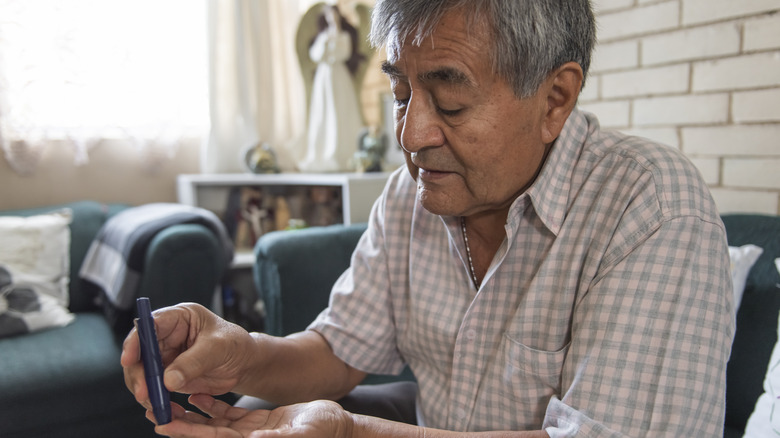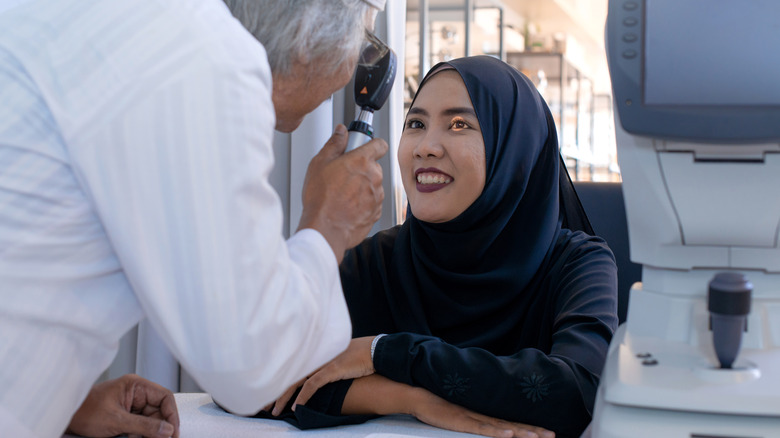Why Hypoglycemia Can Make Diabetic Retinopathy Worse
While it's natural for the body's blood sugar levels to fluctuate on a daily basis, blood sugar levels that fall too low — otherwise known as hypoglycemia — can be harmful to patients with diabetes, particularly when dropping below an average of 70 mg/dL (via American Diabetes Association).
Be on the lookout for signs such as shakiness, fast heartbeat, hunger, nausea, lightheadedness, sweating, weakness, headaches, impaired vision, and more, as such symptoms can point to low blood sugar levels.
For those with diabetes, hypoglycemia can have serious effects on the body if left untreated and can potentially cause seizures or coma. Although rare, in severe cases, low blood sugar levels can also be fatal. Hypoglycemia has also been linked with a condition known as diabetic retinopathy, a condition characterized by vision impairment caused by blood vessel damage in the retina (via Mayo Clinic). Without treatment, those with diabetes stand at an increased risk for diabetic retinopathy.
Low blood sugar levels may prompt an overgrowth of blood vessels in the retina
While some people with diabetic retinopathy may initially be symptom-free, others may experience blurred or darkened vision, spots or floaters, fluctuating vision, or vision loss as the condition worsens.
In a 2023 study published in Cell Reports, researchers set out to determine the underlying cause for the relationship between hypoglycemia and worsened diabetic retinopathy in patients. The researchers used samples of human and mouse retinal cells and intact retinas that were developed in a laboratory low-glucose environment to take a closer look at existing proteins. The study team also looked at mice with sporadic decreases in blood glucose levels.
"Our results show that these periodic low glucose levels cause an increase in certain retinal cell proteins, resulting in an overgrowth of blood vessels and worsening diabetic eye disease," Dr. Akrit Sodhi, the Branna and Irving Sisenwein Professor of Ophthalmology at the Wilmer Eye Institute stated in a Johns Hopkins Medicine press release.
In essence, it was found that low blood sugar hindered retinal cells from effectively breaking down glucose needed for energy output. When unable to break down glucose, the research showed that this prompted excess growth of blood vessels, particularly abnormal, leaky blood vessels, which can lead to vision loss in those with diabetic retinopathy.
How to reduce your risk of diabetic retinopathy
It's important to know that being diagnosed with diabetes does not mean that vision loss is inevitable. Rather, there are ways in which one can help reduce their risk for diabetic retinopathy by practicing preventative measures. This includes keeping up with routine eye exams, managing one's blood pressure and blood sugar levels, and treating any vision issues that develop early on.
Other ways to help mitigate the risk of developing diabetic retinopathy include maintaining a healthy diet, refraining from smoking or tobacco use, and incorporating regular physical activity into your week. Specifically, 150 minutes of moderate aerobic activity weekly is advised (per Mayo Clinic). This can include brisk walking, water aerobics, and leisurely biking on even ground.
While diabetic retinopathy can lead to potential complications, treatment options have come a long way over the years. "Advances in early detection and treatment of diabetic eye disease made possible by retina specialists can preserve sight and virtually eliminate vision loss," Dr. Timothy G. Murray, American Society of Retina Specialists Foundation President, stated in a public news release. "If you have diabetes and experience issues with your sight, partner with a retina specialist for expert care that can prevent, treat or reverse damage to the retina from diabetes."



